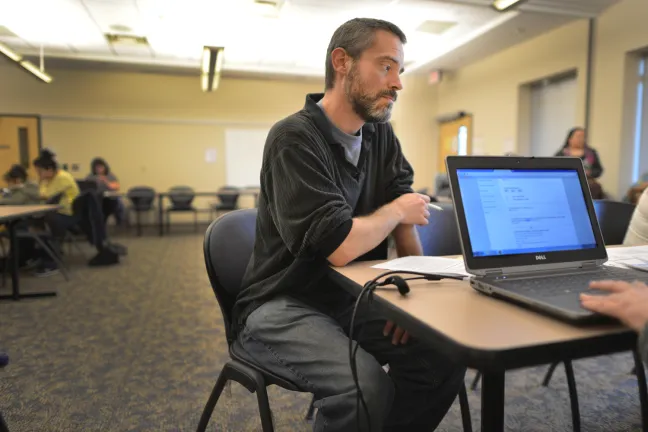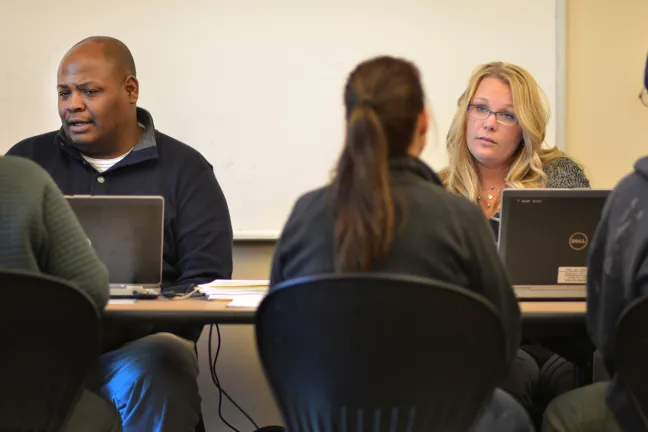Oregonians not covered by health insurance through their work and who do not qualify for Medicaid have a six-week window beginning Nov. 1 to enroll for a plan through HealthCare.gov. Enrollment ends at 9 p.m., Dec. 15.
But no one has to navigate the enrollment process on their own, said Rosamaria Rosales, the insurance enrollment supervisor for the Multnomah County Health Department. Her team of eligibility specialists is holding six weeks of free clinics at county health centers and library branches to help residents navigate the federal insurance marketplace.
Rosales has hosted free clinics each year since the Affordable Care Act went into effect. “It’s been very fulfilling,” she said. “Some people have never had insurance. Some had pre-existing conditions so being able to have some insurance and preventative care was good news for them.”
Some people who enroll on the marketplace find they have to pay a premium, and that can alarm residents on a tight budget. “Some monthly premiums are $200 or even $300, that’s a car payment,” Rosales said. She tells them about Portland nonprofit Project Access NOW, which has a fund to help pay the premium for residents who earn up to 300 percent of the poverty level.
Like the free clinics offered through Multnomah County, Project Access NOW also has a team that helps families understand their health insurance options. But this year they’re operating on a tight timeline. The Trump administration limited open enrollment to six weeks, down from three months in previous years. The administration also cut by 90 percent its $100-million budget intended to educate the public about enrollment.
“We have half the time to enroll the same population,” said Sean McAnulty, policy and advocacy coordinator for Project Access NOW. “We’re doing as much work as we can in advance to make sure clients have all their documents ready to go.”
Meanwhile Oregon’s Department of Consumer and Business Services, which oversees the state’s health insurance exchange, has increased its budget for education and outreach. They’ve have launched a social media campaign, and invested in print and radio advertising. For the first time, they’re investing in television too, to limit the blow from the loss of federal publicity dollars.
“One of the biggest things we do is outreach, with community groups, tribes, insurance agents, community partners,” said Jake Sunderland, a press officer with the DCBS. “Because Trump did cut the advertising budget, we upped ours,” he said. But “I’d don’t think you can match the ad-buy from the federal government that was millions of dollars.”
Nonprofit and grassroots groups are also stepping up to get the word out too to people who might now be aware that they must still have insurance, should examine their options and enroll by Dec. 15.
“I’m terrified my patients won’t know what’s going on, that they’ll be left without insurance or they’ll be stuck with a plan that doesn’t work for them,” said Dr. Smitha Chadaga, assistant site director at Emanuel Hospital and a volunteer for a grassroots group called ACA Signups. “The ACA revolutionized my job. People get the follow up they need, the medication they need, the homecare they need.”
Chadaga has worked in hospitals for 15 years. Before the Affordable Care Act expanded people’s access to Medicaid and made private insurance more accessible — and mandatory — Chadaga said. Patients who didn’t have insurance and couldn’t pay out of pocket for costly medications might be sent home with something that was “not optimum,” she said.
“I’d pick the best I could find, not the best I had,” she said. “Now they’re getting the appropriate care.”
Multnomah County community health center staff screen every new patient for insurance eligibility, and help those patients enroll. The county beefs up its eligibility team during the annual open enrollment for those patients who make too much to qualify for Medicaid, but who do not receive insurance through their jobs.
Since the Affordable Care Act went into effect, the percent of uninsured patients visiting Multnomah County’s health centers dropped by nearly half. In 2012, 31 percent of clients were uninsured. By 2014, the first year the ACA went into effect, that dropped to 19 percent. Today it hovers about 16 percent.
“We have a vested interest in making sure clients have access. Enrolling people helps make sure patients get the care they need,” said Adrienne Daniels, deputy director of Integrated Clinical Services. “The health department’s vision is healthy people in healthy communities, and one of the clearest ways to get there is to lower barriers to clinical health care. Insurance is proven way to get there.”


